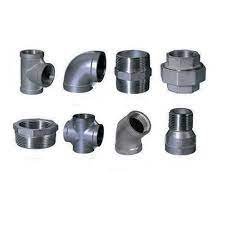Advantages of Stainless Steel 316H Forged Fittings
Stainless Steel 316H Forged Fittings

Stainless Steel 316H forged offers numerous advantages over other materials and types of fittings due to their unique properties and characteristics. These advantages make them highly desirable for a wide range of industrial applications. Below are some of the key advantages of SS 316H forged fittings:
1. Corrosion Resistance:
One of the primary advantages of Stainless Steel 316H forged fittings is their exceptional corrosion resistance. The presence of chromium, molybdenum, and nickel in the alloy composition forms a protective oxide layer on the surface, which prevents corrosion and ensures longevity in corrosive environments. These fittings are resistant to various corrosive agents, including acids, alkalis, and chloride solutions, making them suitable for use in harsh chemical processing, marine, and offshore environments.
2. High-Temperature Strength:
SS 316H forged fittings exhibit excellent high-temperature strength, making them ideal for applications involving elevated temperatures. The higher carbon content in grade 316H enhances its high-temperature properties compared to standard grade 316 stainless steel. These fittings retain their mechanical properties even at elevated temperatures, ensuring reliable performance in high-temperature applications such as power generation, chemical processing, and petrochemical industries.
3. Superior Mechanical Properties:
Stainless Steel 316H forged fittings possess superior mechanical properties, including high tensile strength, yield strength, and toughness. These fittings can withstand high-pressure environments and mechanical stresses without experiencing deformation or failure. The combination of excellent mechanical properties and corrosion resistance makes Stainless Steel 316H forged fittings suitable for critical applications where structural integrity and reliability are paramount.
4. Versatility and Compatibility:
Stainless Steel 316H forged fittings are highly versatile and compatible with a wide range of piping systems and components. They can be easily integrated into existing piping systems or used in new installations due to their dimensional accuracy and standard specifications. These fittings are available in various shapes, sizes, and configurations, including elbows, tees, couplings, and unions, offering flexibility in designing and constructing piping systems to meet specific project requirements.
5. Weldability and Fabrication Ease:
Stainless Steel 316H forged fittings are readily weldable using conventional welding techniques, including TIG welding, MIG welding, and arc welding. This weldability allows for easy fabrication and customization of fittings to suit the needs of different piping applications. Fabrication processes such as bending, machining, and forming can also be performed on Stainless Steel 316H forged fittings with ease, enabling the creation of complex shapes and configurations as per project specifications.
6. Longevity and Durability:
316H SS forged fittings are known for their durability and longevity, even in demanding industrial environments. These fittings have a high resistance to wear, abrasion, and corrosion, ensuring extended service life and minimal maintenance requirements. Their robust construction and resistance to degradation make them a cost-effective solution for long-term use in critical applications across various industries.
7. Hygienic Properties:
In industries such as pharmaceuticals, food and beverage, and biotechnology, Stainless Steel 316H forged fittings offer hygienic properties that meet stringent regulatory requirements. These fittings are easy to clean, non-toxic, and non-reactive, making them suitable for use in sanitary piping systems where product purity and cleanliness are essential.
8. Aesthetic Appeal:
Stainless Steel 316H forged fittings not only offer excellent functional properties but also provide aesthetic appeal in architectural and decorative applications. Their sleek and polished surface finish not only enhances the visual appearance of piping systems and components but also makes them suitable for use in architectural structures, interior design elements, and high-end construction projects.
9. Resistance to Scaling and Oxidation:
Stainless Steel 316H forged fittings exhibit excellent resistance to scaling and oxidation at high temperatures. This property allows them to maintain their structural integrity and appearance even when exposed to elevated temperatures for prolonged periods. As a result, these fittings are suitable for applications involving heat treatment processes, thermal cycling, and high-temperature service conditions.
10. Low Maintenance Requirements:
Another advantage of Stainless Steel 316H forged fittings is their low maintenance requirements. Due to their corrosion resistance, durability, and longevity, these fittings require minimal upkeep over their service life. This reduces downtime and maintenance costs associated with replacing or repairing fittings, contributing to overall cost savings for industrial operations.
11. Environmental Sustainability
Stainless Steel 316H forged fittings are environmentally sustainable due to their recyclability and long service life. Stainless steel is a highly recyclable material, and the recycling process requires less energy compared to the production of new stainless steel. Additionally, the longevity of SS 316H forged fittings reduces the need for frequent replacements, leading to lower environmental impact and resource consumption over time.
12. Enhanced Chemical Compatibility:
Stainless Steel 316H forged fittings offer enhanced chemical compatibility, allowing them to withstand exposure to a wide range of chemicals and solvents without degradation or corrosion. This property makes these fittings suitable for use in industries where compatibility with various chemicals and substances is crucial, such as pharmaceutical manufacturing, chemical processing, and laboratory applications.
13. Fire Resistance:
These products exhibit inherent fire resistance, making them suitable for applications where fire safety is a concern. These fittings do not contribute to the spread of fire and are capable of withstanding high temperatures without losing their structural integrity. As a result, they are commonly used in fire protection systems, industrial furnaces, and structural applications where fire resistance is essential.
14. Regulatory Compliance:
SS 316H forged fittings comply with various industry standards and regulatory requirements, ensuring their suitability for use in critical applications across different sectors. These fittings meet the specifications outlined by organizations such as ASTM International, ASME, ANSI, and API, ensuring quality, performance, and safety by industry standards.
15. Cost-Effectiveness:
Despite their numerous advantages, Stainless Steel 316H forged offers cost-effectiveness over the long term. While the initial investment may be higher compared to fittings made from other materials, the durability, longevity, and low maintenance requirements of 316H forged fittings result in lower lifecycle costs. This makes them a cost-effective solution for industrial applications where reliability and performance are essential considerations. Additionally, SS 316H forged fittings offer significant long-term cost savings due to their durability and low maintenance requirements.
In conclusion, SS 316H forged fittings offer a multitude of advantages, including corrosion resistance, high-temperature strength, superior mechanical properties, versatility, weldability, durability, and aesthetic appeal. These advantages make them a preferred choice for critical applications in industries such as chemical processing, power generation, oil and gas, pharmaceuticals, food and beverage, aerospace, and construction, where reliability, performance, and longevity are essential requirements.



